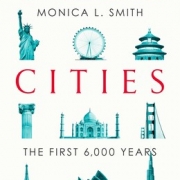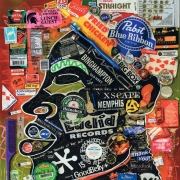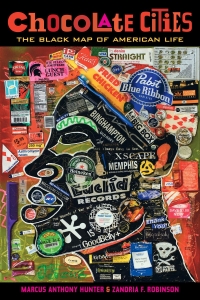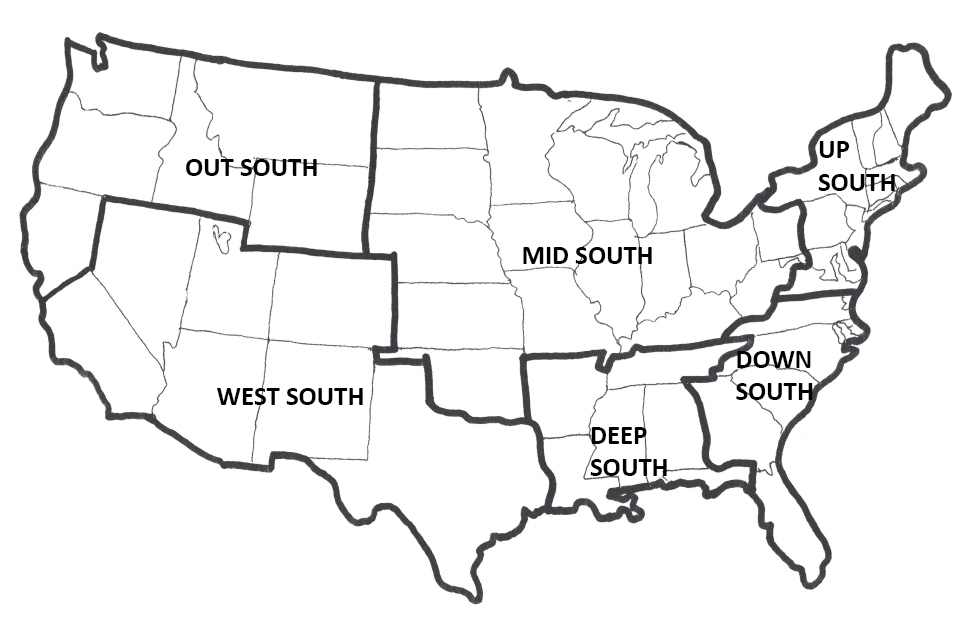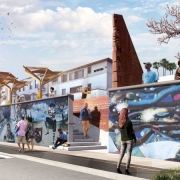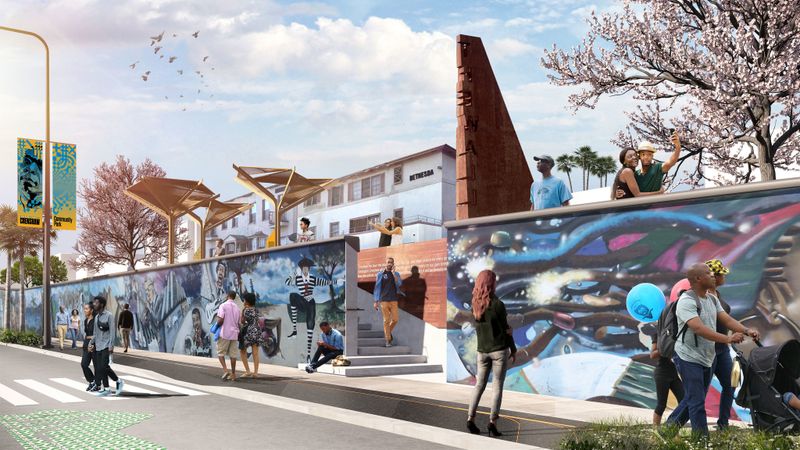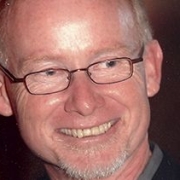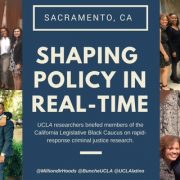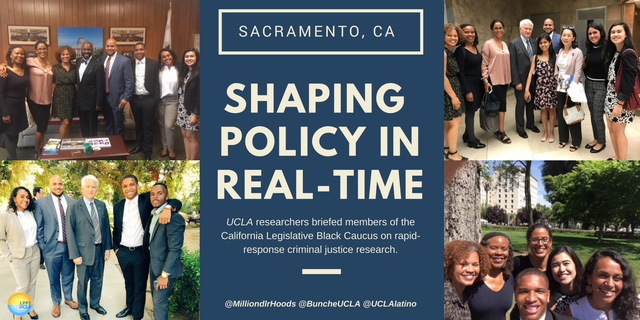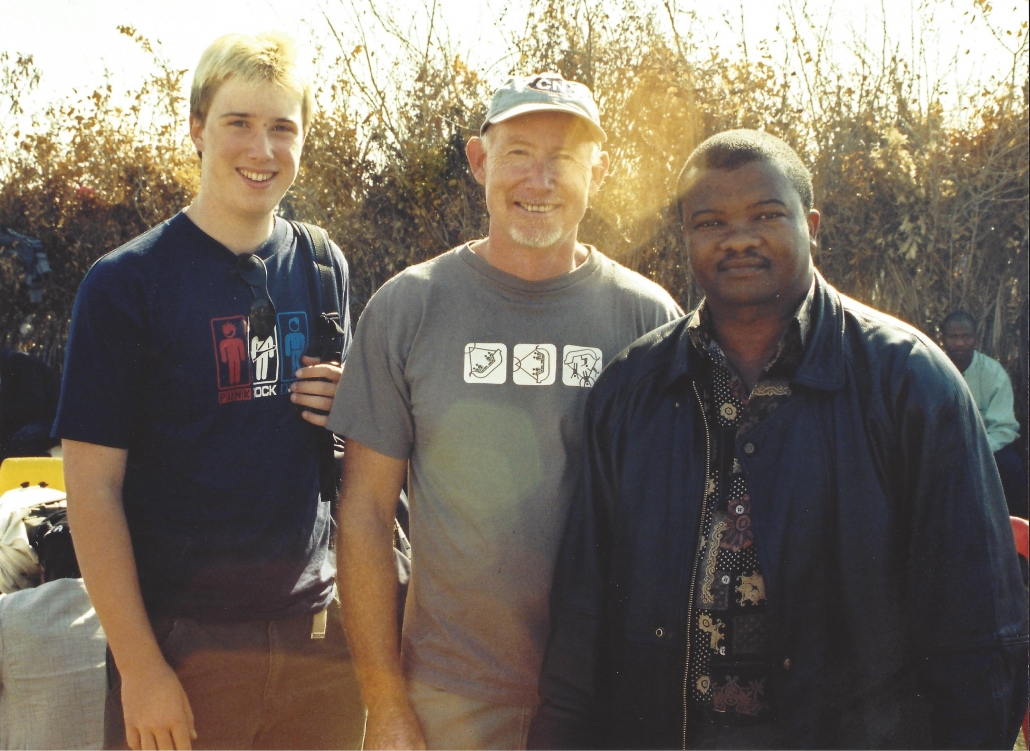
Featured in photo: Tom Worger, Bill Worger, and Bantu Holomisa, future leader of the United Democratic Movement, at a wedding in Gazini, Eastern Cape, 2002
Dr. Bill Worger, Professor of History at UCLA, is working on some really interesting projects. Recently, we caught up with Professor Worger to chat about teaching online classes, a research initiative that digitizes anti-apartheid posters, and comic books.
LASS: Where are you from and where did you go to school?
BW: I grew up in New Zealand, first generation New Zealander. I became a teenager in the 1960s when most African and most Asian countries were becoming newly independent states, and I got fascinated in studying their history.
LASS: Where did you go to school and why did you study what you studied?
BW: I went to the University of Auckland, and I think something that was unique about the University of Auckland in the 1960s compared to practically every other university in New Zealand or in Canada or Australia or another part of the so-called “white Commonwealth,” was that there were three professors of history: one of them did New Zealand history; one did Africa; one did Southeast Asia. I didn’t grow up as a person who was going to spend my whole life studying Europe and the United States.
LASS: Now fast forward to UCLA, what do you do here at UCLA and what do you study here?
BW: I came to UCLA in 1989 to teach African history in general and South African history specifically. Looking back, I first came to the United States for my PhD in 1975. Most New Zealanders were expected to go overseas and most went to Britain and became part of the expat colonial community. I decided to come to the States. After my PhD which I received in ’82 from Yale, I taught at the University of Michigan, I taught at Stanford University, and then I came to UCLA, which had arguably one of the best African history programs in the nation and has had that since the 1960s.
LASS: What are you currently teaching right now that excites you?
BW: I’m teaching two courses: one course is History 10B, the history of Africa since 1800, which I’m teaching as an online class to 420 students, most of them first- or second-year students who need a GE. I’m finding that fascinating because of the various work that they do, such as exploring all the resources we have on campus by, for example, doing a field work assignment which asks them to take selfies with an Africa-related item at the botanical gardens, at the Fowler Art Museum, and at the map collection in the library. They are finding out that they’re discovering the campus thoroughly for the first time in their lives. The other class I am teaching is a graduating senior research seminar where I’m asking the students to use two series of comics. One, Mighty Man, was published surreptitiously by the South African government in the 1970s to persuade residents of Soweto to fight crime and support apartheid; the other, the Black Panther, has a lengthy storyline published in 1989 which focuses on the struggle against apartheid. I want my students to see the ways in which popular culture is developed and the ways in which publications such as comics represent history, reflect it, and affect it.
LASS: That’s amazing. Can you tell me more about the initiative that you started with the comics and how you’ve worked with the UCLA libraries to share them with the world?
BW: I first went to South Africa in 1977, probably two months after Stephen Biko, a major leader of the anti-apartheid movement, had been killed in prison by the South African authorities, although they never admitted their responsibility until 20 years later and maybe not even now. Much the material then had been banned, the African National Congress had been banned for a long time, I mean it was an incredibly authoritarian society, essentially a police state, and it was highly segregated. Different entrances to the post office. I could go in as a white person. If you were black, you had to go through a separate entry.
If you were “Coloured,” a South African legal definition of the time, there was a separate bus for you. The apartheid government defined everybody as either white or African or Indian or “Coloured.” So many different divisions in daily life. As I have taught the history of South Africa, I’ve been interested especially since the end of apartheid in 1994 when Nelson Mandela became president, to see the ways in which materials that were previously banned or pushed underground or censored or were not supposedly available in the archives can now be accessed. There’s so much that’s creeping out.
In this particular case, I became aware probably about five years ago of the existence of these comics. I’m not quite sure how I found it. But it was partly through looking at comic blogs. And I’m also a believer in collecting things off eBay. This collection became available on eBay simply because some American had collected Mighty Man, and I purchased the whole collection and have worked closely with people at YRL [Young Research Library at UCLA] to digitize it to make it available. Not only to all of us here at UCLA but to the wider public both in North America and in South Africa where they’re seeing these for the first time since most of them were destroyed literally in 1976.
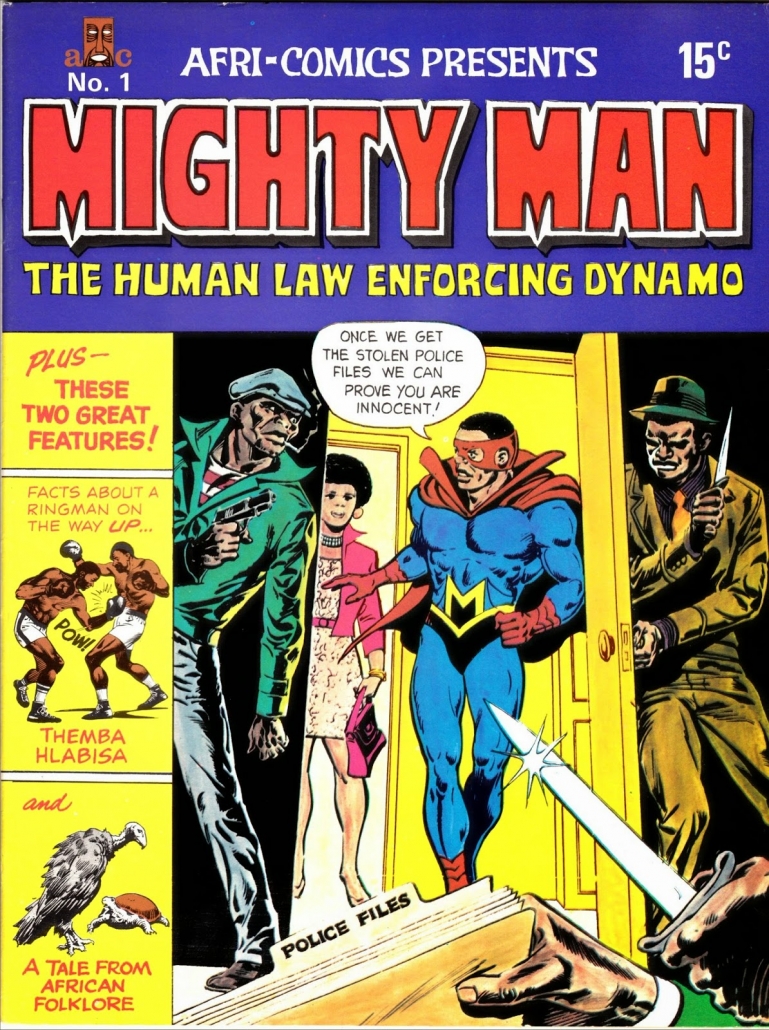
http://southafricancomicbooks.blogspot.com/2015/01/afri-comics-mighty-man-series.html
“What I find is in many of these initiatives we are pursuing at UCLA that they are being very well received and accepted in South Africa, particularly by black historians, who have been still and to this present day remain marginalized by academia. But these young scholars are the people on the ground and the ones who have the community knowledge and the language skills to understand their own history.” – Professor Bill Worger
LASS: Why is this work important?
BW: I think it’s important work in terms of people finding out and rediscovering their history. I’ve gone to South Africa and talked to younger people, younger black students in particular, who feel that much of the history of apartheid is the history of their parents. It’s not something that affects them immediately since they are often students born after 1994 and they can’t quite understand why their parents either won’t talk about apartheid or why they have so many terrible memories. What I find is in many of these initiatives we are pursuing at UCLA that they are being very well received and accepted in South Africa, particularly by black historians, who have been still and to this present day remain marginalized by academia. But these young scholars are the people on the ground and the ones who have the community knowledge and the language skills to understand their own history.
What I feel like is that it’s important to provide these people with access, which we can do uniquely at UCLA. The materials that they themselves can access or digitize, either because they’re not in their libraries or because of the costs involved. This is part of understanding their history and learning more about it, because they’ve got a fragmented notion of their past particularly because history has been so controlled by white authorities in South Africa both during the apartheid era and even to the present day in terms of those who teach in universities.
LASS: What types of new knowledge does this project and initiative generate?
BW: It produces new knowledge, new sources, and new ways of talking about the past, particularly the student uprising in Soweto in 1976. There’s a fascinating television series “When We Were Black” made by black South Africans, including Professor Sifiso Ndlovu, who as a 13 year-old was one of the student protestors in 1976. This TV series in a very low-key way shows the ways in which children, high school children, were politicized by daily activities. It’s a very powerful film. Access to the Mighty Man comics (none of which remain in public circulation in South Africa) for Professor Ndlovu and his peers and students provides yet another form of evidence to show the ways in which the government was trying to manipulate young people during the apartheid era. Trying to affect their minds in visual ways particularly through the utilization of comics. This is just one project in which I’m engaged but there are so many ways in which you can delve back in, and, in a sense, disinter hidden histories.
LASS: There’s such relevancy to that with what’s going on today, right, in popular culture and in the media and in the news. I imagine your students are able to when they learn about these materials and take these classes and participate in this research, are developing a critical way to extrapolate.
BW: I emphasis generational empathy and understanding in a lot of my classes. What I like to ask my students to do, most of whom are in their late teens, early to mid twenties is to think about their own family histories. Think about where they are right now. In the seminar, I’m teaching on comparing Mighty Man and the Black Panther. I’ve got a fair number of students who were born in the United States, but they’re of Iranian descent. With them, I’m asking them, think about what was happening in Iran as of the 1970s or what was happening as of their parents’ generation.
Let’s say if I’m talking about South Africa in the middle of the 1870s when we get the development of an industrialized, very modern, but very repressive racial society. What would your family have been doing at that time? I’ve had students who are African American who are only a few generations removed from slavery, or the Jim Crow racism of the late 19th and 20th centuries. I’ve had students who are descendants of white slave owners in the US South. I’ve had students from other parts in the world, from Asia and the Middle East, who I have asked to think about what their families were doing as of around 1870, because I want people to reimagine themselves into these situations. It’s not just solely an objective past to be looked at, it’s something to be rethought and relived in. We use a multitude of sources.
LASS: What type of solutions will be derived from that?
BW: I’m old enough now to know there are never any solutions. What I emphasize to my students, and this is the most remarkable thing, which is if we really want to find social mobility in the world, in a world that’s basically unfair and obviously discriminatory in many ways, education is the way in which you can achieve some social mobility. It’s absolutely key. It’s the way no matter how oppressed you are, how discriminated, how marginalized, through education you can succeed in both changing your own position and those of your family and those who surround you. You can also change yourself in terms of how you think about anything. You can always be free in your own mind.
In a way that for so many of the people that I study in South Africa, for example, the end of apartheid has not meant the end of poverty or marginalization or discrimination. But, people in their minds have become free and that gives them a very different perspective at how they look around at other people and at the problems they have in their lives.
LASS: In all your work, your teaching, your research, the projects that you engage in, what’s the big impact that you’re hoping to make?
BW: It’s always incremental. It’s always the little things. I’m delighted to engage in conversations and have my students take over. I would hope that one or more of those 420 students in 10B go away with an understanding that history is not just the statistics and the facts and that there’s a solution and life gets better all the time, but there are constant struggles and everybody needs to be respected. In dealing with my South African colleagues, I understand history has to be transformed there; it has to become possessed by the people who are the majority of the country, and the people who have indigenous knowledge of the 11 or so languages there. They’re the people who are going to revolutionize history. I’ve been part of the incremental change, but it’s only a small part.
LASS: I know prior to the turning on the recorder we talked a little bit about a new research grant that you’re applying for, that you are hoping to get funded. Tell us about that. I’m excited to learn more about that.
BW: I told you about two research grants. One of which actually has already got funded by the Office of the UC President, which will enable me to go to South Africa with my wife, Professor Nancy Clark, who is also an historian of South Africa and where we will actually work on developing lectures based on site, at the places where events actually happened and where we will do a different history which focuses the majority of the people in the country. We hope that we can then share it with the people there and again be part, a small part, of the development of the historical profession in that country. I’m also waiting to find out about another grant that I worked on with a couple colleagues at UCLA. This is a grant to support another UC-HBCU initiative to hopefully bring to UCLA each summer, 10 students from Spelman, Howard University and North Carolina Central University, who will come to UCLA and spend their time meeting with faculty and with fellow students who are interested in what I would in term the engaged social sciences. That is academic study that is aimed towards improving society. A very general term, I know, but we can incrementally make the world around us a slightly better place on the basis of what we discover and what we find out in our academic work.
LASS: With that, thank you so much. It’s there anything that I didn’t ask or I should know about?
BW: So we have in Los Angeles probably the world’s biggest collection of political posters at the Center for the Study of Political Graphics. It’s just an incredible resource in Culver City. I’m working with colleagues in South Africa and with colleagues at YRL to develop a grant so that we can digitize the approximately 1,000 anti-apartheid posters that this collection has.
These are posters that were made in the United States, they were made in the Soviet Union when it was the Soviet Union. They were made in Cuba. They were made in all parts of the world and they are posters that were created as part of the anti-apartheid struggle. None of these posters are available in South Africa because they would have been banned so they could never have been circulated.
If any of them did circulate, say surreptitiously, in South Africa the police and military would have destroyed them so they are not available there. So what I am working with, as I say, with colleagues at YRL and in South Africa is to get a grant to digitize these materials so that we can create a public archive of anti-apartheid materials that would then be accessible to young black South Africans who can see the ways in which the entire world was engaged to end apartheid and end white supremacy in their country.
It becomes a research resource for people who are interested in history, but it also becomes something whereby people understand communication and mutual interest across generations and across boundaries.
LASS: Thank you!
UPDATE: As of June 6, 2018, Professor Worger informed us that a fellow historian from South Africa, Dr. Chitja Twala, Head of the History Department at the University of the Free State in Bloemfontein, had been awarded a fellowship by the Mellon Foundation that will enable him to spend three months at UCLA in 2019. Dr. Twala will arrange the digitization of the anti-apartheid posters at the Center for the Study of Political Graphics in Culver City, CA. UCLA’s Young Research Library will then arrange for the uploading and archiving of these posters so that they will be freely available worldwide.
Dr. Bill Worger was interviewed by Mike Nguyen, an assistant editor and contributor to LA Social Science.
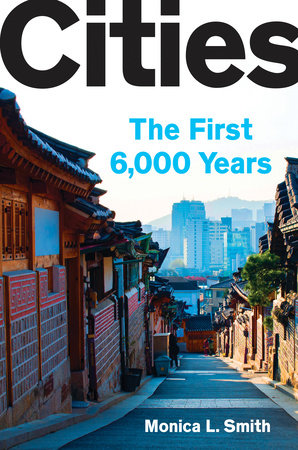
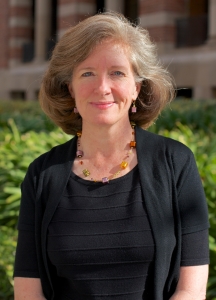 “This book explores what makes cities a compelling part of human life, and how over the past six thousand years they have become the dominant form of human settlement. The growth of cities wasn’t an easy process and those who live in cities find them challenging and exciting in equal measure. There is crowding, pollution, high prices, and traffic, but at the same time there are amazing job opportunities, educational and medical facilities, and the possibilities of entertainment ranging from major sports teams to museums, art galleries, and theaters. Cities are also places of much greater diversity, whether that’s ethnic diversity, migrant neighborhoods, or LGBTQ communities. Cities are places of great economic growth and they’re linked together into a global network of connected places.”
“This book explores what makes cities a compelling part of human life, and how over the past six thousand years they have become the dominant form of human settlement. The growth of cities wasn’t an easy process and those who live in cities find them challenging and exciting in equal measure. There is crowding, pollution, high prices, and traffic, but at the same time there are amazing job opportunities, educational and medical facilities, and the possibilities of entertainment ranging from major sports teams to museums, art galleries, and theaters. Cities are also places of much greater diversity, whether that’s ethnic diversity, migrant neighborhoods, or LGBTQ communities. Cities are places of great economic growth and they’re linked together into a global network of connected places.”
